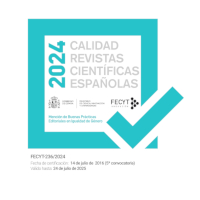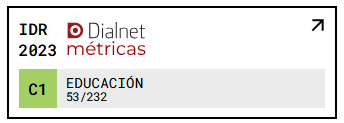Nautilus reading and poetic education in the digital environment
DOI:
https://doi.org/10.18172/con.5234Keywords:
Reading habits, digital Reading, creative writing, reader formation, haikuAbstract
In recent decades, the impact of digital technology has been constant. Its invasive, omnipresent and addictive nature (Steiner-Adair and Baker, 2013) has affected not only our way of approaching the written text, but also the reader himself. Especially in the new generations, who continually coexist with an overabundance of information –which they fail to transform into knowledge – and digital offerings for leisure. A mutation that is reflected in the classroom. Therefore, this work tries to define the profile of the new digital readers through a series of metaphors. And, once defined, it is proposed to counteract the reading habits of today’s students through a creative, active and interdisciplinary literary education. To counteract the superficiality and reading Josep M. Rodríguez Cabrera Contextos Educ., 30 (2022), 271-283 272 impatience of the learners, the teaching and learning of short literary forms, such as the flash fiction, the aphorism, the greguería and especially the haiku, from which some educational experiences developed in Spanish territory are collected.
Downloads
References
Arroyo Moliner, L. (2020). Tú no eres tu selfi: 9 secretos digitales que todo el mundo vive y nadie cuenta. Lleida: Milenio.
Benjamin, W. (2012). El París de Baudelaire. Buenos Aires: Eterna Cadencia.
Bernabeu Morón, N. y Goldstein, A. (2008). Creatividad y aprendizaje: El juego como herramienta pedagógica. Madrid: Narcea.
Birkerts, S. (1994). The Gutenberg Elegies: The Fate of Reading in an Electronic Age. Boston: Faber and Faber.
Bloom, H. (2000). Cómo leer y por qué. Barcelona: Anagrama.
Bordons, G. y Ferrer, J. (2009). Introducció. En G. Bordons (coord.). Poesia i educació: D’internet a l’aula (pp. 7-13). Barcelona: Graó.
Bravo-Villasante, C. (1990). Los grandes poetas y el niño. En P. Cerrillo y J. García Padrino (eds.). Poesía infantil: Teoría, crítica e investigación (pp. 51-57). Cuenca: Universidad de Castilla-La Mancha.
Carr, N. (2011). Superficiales: ¿Qué está haciendo Internet con nuestras mentes? Madrid: Taurus. DOI: https://doi.org/10.12795/AdMIRA.2011.01.11
Castoriadis, C. (2013). La institución imaginaria de la sociedad. Barcelona: Tusquets.
Cernuda, L. (1992). La realidad y el deseo. México: Fondo de Cultura Económica.
Cerrillo, P. C. y Luján Atienza, A. L. (2010). Poesía y educación poética. Cuenca: Universidad de Castilla-La Mancha.
Cervera, J. (1991). Teoría de la literatura infantil. Bilbao: Mensajero.
Colinas, A. (2016). Bajo las alas negras de los abetos. Ínsula, 838, 51-52.
Concheiro, L. (2016). Contra el tiempo: Filosofía práctica del instante. Barcelona: Anagrama.
Delmiro Coto, B. (2002). La escritura creativa en las aulas: En torno a los talleres literarios. Barcelona: Graó.
Desclot, M. (2007). Poesies amb suc: Antologia de poesia per a infants. Barcelona: La Galera.
Entwistle, N. (1988). La comprensión del aprendizaje en el aula. Madrid: Paidós/MEC.
Gil de Biedma, J. (2010). Obra: Poesía y prosa. Barcelona: Galaxia Gutenberg.
Gómez Díaz, R., García Rodríguez, A., Cordón García, J. A. y Alonso Arévalo, J. (2016). Leyendo entre pantallas. Gijón: Trea.
Issa, K. (2008). Poemas de madurez. Lucena: Juan de Mairena.
Jean, G. (1996). La poesía en la escuela: Hacia una escuela de la poesía. Madrid: Ediciones de la Torre.
Kafka, F. (2017). Diarios. Barcelona: Debolsillo.
Lara Cantizani, M. (2004). Once de marzo: Antología de haikus desde Lucena. Béjar: LF.
Lara Cantizani, M. (2005). Haikus del mal amor. Málaga: Diputación de Málaga (CEDMA).
Lara Cantizani, M. (2006). Deshielo en primavera: Antología de haikus. Málaga: Diputación de Málaga (CEDMA).
Lara Cantizani, M. (2019). Resiliencia de 17 sílabas (Alfileres, 11M y mi tumor cerebral). Ínsula, 870, 38-40.
Locke, J. (2012). Pensamientos sobre la educación. Madrid: Akal.
Marina, J. A. y Válgoma, M. de la (2007). La magia de escribir. Barcelona: Plaza & Janés.
Martínez-Ezquerro, A. (2020). Lecturas para la diversidad: competencias y variables de uso en los futuros maestros. Ocnos, 19(3), 72-83. https://doi.org/10.18239/ocnos_2020.19.3.2316 DOI: https://doi.org/10.18239/ocnos_2020.19.3.2316
Martos Núñez, E. (2010). De la República de las Letras a Internet: de la Ciudad Letrada a la cibercultura y las tecnologías del S. XXI. Álabe, 1, 1-16. https://doi.org/10.15645/Alabe.2010.1.3. DOI: https://doi.org/10.15645/Alabe.2010.1.3
Mora, V. L. (2021). La lectura como tapiz cognitivo. Ínsula, 894, 20-24. DOI: https://doi.org/10.36631/ECO.2021.24.01
Moreno, V. (1994). El deseo de escribir: Propuestas para despertar y mantener el gusto por la escritura. Pamplona: Pamiela.
Moreno, V. (2005). Metáforas de la lectura. Madrid: Lengua de Trapo.
Organización para la Cooperación y el Desarrollo Económicos (OCDE) (2020). PISA 2018 Annex A9. A note about Spain in PISA2018: Further analysis of Spain’s data bytesting date. https://www.oecd.org/pisa/PISA2018-AnnexA9-Spain.pdf.
Perriconi, G. (1984). El lenguaje poético. En G. Perriconi y A. Wischñevsky. La poesía infantil (pp. 1-11). Buenos Aires: El Ateneo.
Piaget, J. (1983). La psicología de la inteligencia. Barcelona: Crítica.
Prensky, M. (2001). Digital natives, digital immigrants. On the Horizon, 9(5), 1-6. https://educ116eff11.pbworks.com/f/prensky_digital%20natives.pdf DOI: https://doi.org/10.1108/10748120110424816
Proust, M. (1997). Sobre la lectura. Valencia: Pre-Textos.
Rodari, G. (1983). Gramática de la fantasía: Introducción al arte de inventar historias. Barcelona: Argos Vergara.
Rodríguez, J. M. (2019). ¿Y si escribes un haiku? Santa Coloma de Gramenet: La Garúa.
Rodríguez, J. M. (2021). El hábito lector y los mundos del texto. Ínsula, 894, 2-5.
Rodríguez-Izquierdo, F. (1994). El haiku japonés. Madrid: Hiperión.
Roqueta-Fernàndez, M. (2019). De la poma a la pantalla: Amor, sexe i desig a l’època digital. Lleida: Milenio.
Rovira, P. (1996). Los poemas necesarios: Estudios y notas sobre la poesía del medio siglo. Palma de Mallorca: Universitat de les Illes Balears.
Ruiz, C. M. (2020). El Señor de los dígitos: Internauta, poder simbólico y responsabilidad en el ciberespacio. En F. Torralba, J. Garcia del Muro y C. M. Ruiz. Verdad, posverdad y fake news (pp. 15-41). Lleida: Milenio.
Salvador Ayastarán, I. y García García, I. (1998). Haikú: Poesía pintada. Alcantarilla: IES Francisco Salzillo.
Sánchez García, F. J. (2021). Educar la mirada. El discurso informativo de las fake news en el currículo de secundaria y bachillerato. Contextos educativos, 27, 153-167. https://doi.org/10.18172/con.4865 DOI: https://doi.org/10.18172/con.4865
Sánchez García, M. R. y Aparicio Durán, P. (2020). Los hijos de Instagram. Marketing editorial. Poesía y construcción de nuevos lectores en la era digital. Contextos educativos, 25, 41-53. http://doi.org/10.18172/con.4265 DOI: https://doi.org/10.18172/con.4265
Séneca, L. A. (2020). Cartas a Lucilio. Madrid: Cátedra.
Serna, J. (2017). Leer el mundo: Visión de Umberto Eco. Madrid: La Huerta Grande.
Steiner-Adair, C. y Barker, T. H. (2013). The Big Disconnect: Protecting Childhood and Family Relationships in the Digital Age. Nueva York: Harper.
Teplov, R. M. (1986). Aspectos psicológicos de la educación artística. En Luria, Leontiev y Vigotsky. Psicología y pedagogía. Madrid: Akal.
Turguéniev, I. (2011). Padres e hijos. Madrid: Akal.
WeAreSocial (2021). Digital 2021. https://wearesocial.com/digital-2021.
Wolf, M. (2020). Lector, vuelve a casa: Cómo afecta a nuestro cerebro la lectura en pantallas. Barcelona: Deusto.
Downloads
Published
How to Cite
Issue
Section
License
The authors retain copyright of articles and authorize Contextos Educativos. Revista de Educación the first publication. They are free to share and redistribute the article without obtaining permission from the publisher as long as they give appropriate credit to the editor and the journal.
Self-archiving is allowed too. In fact, it is recommendable to deposit a PDF version of the paper in academic and/or institutional repositories.












